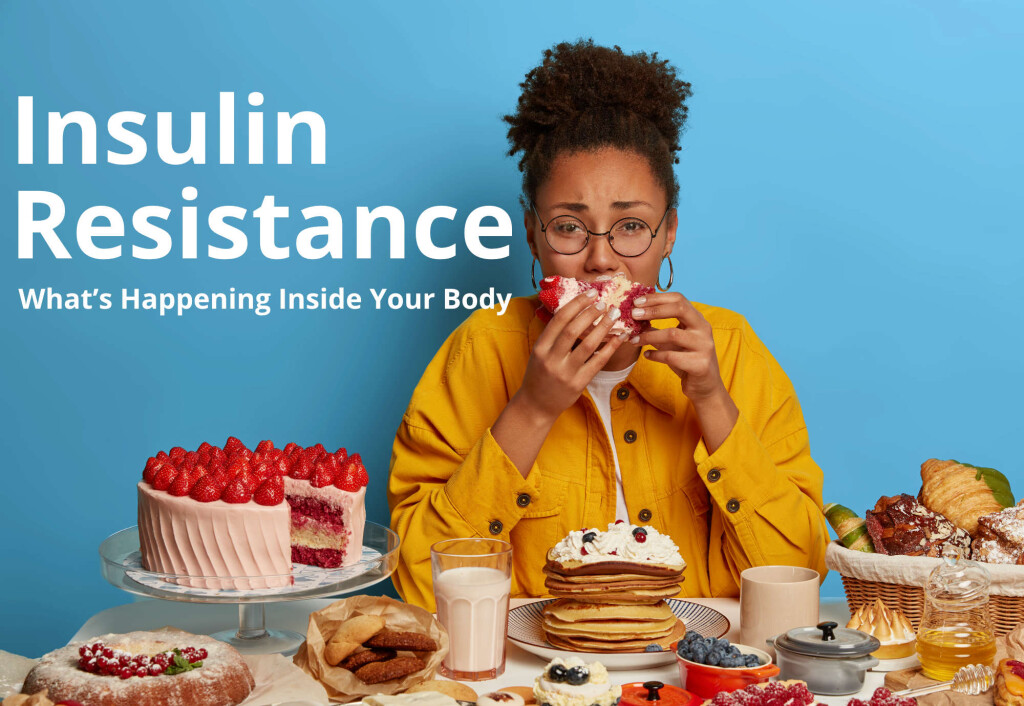
Insulin Resistance: What’s Happening Inside Your Body
You’ve heard the term “insulin resistance,” but do you know what it’s doing to you? It’s not just a medical buzzword—it’s a silent battle in your cells that’s draining your energy, piling on fat, and setting you up for serious health issues. Let’s cut through the noise and get personal about what’s happening inside your body—and how you can support your body, so your body can support your life.
Your Cells Are Starving, Even When You’re Full
Because so many of us are getting our energy from sugar, carbs (often from heavily processed foods) our body gets way more sugar than it needs. Our Insulin levels rise to deal with the significant increase in blood sugar which then becomes...
Imagine this: you eat a meal, your stomach’s full, but your cells are screaming for fuel. Insulin, the hormone that’s supposed to unlock your cells to let in glucose and nutrients, isn’t getting through. Your cells are slamming the door shut, resisting insulin because your pancreas is pumping out five to seven times more than it should. Why? To protect themselves from insulin overload. But this leaves your cells starved for glucose, proteins, and nutrients they need to power your body.
Here’s the kicker: because your cells are starving and calling out for glucose, proteins, and nutrients your body’s response is to crank up insulin even more, to try to get more nutrients into the cells creating a vicious cycle. Your cells stay hungry, and the excess glucose in your blood gets stored as glycogen or shoved into fat storage—especially around your belly. You feel sluggish, crave sweets after a meal despite just having eaten, and wonder why you’re so “hangry” between meals. That’s insulin resistance messing with you.
The Fallout in Your Body
This isn’t just about feeling off. Your body’s paying a price:
Energy Crash: Your cells can’t use glucose properly, so it’s stored as fat instead of fueling your day. You’re tired, irritable, and craving sugar to fill the gap because despite have good blood sugar, your cells can't access it because of the insulin. Insulin can't open the cell to do it's job, the cell can't get the nutrients so insulin has to lower the blood sugar and store it. What an awful cycle the body is in.
Stress Overload: Your adrenals pump out cortisol and adrenaline to keep your blood sugar from crashing too hard due to high insulin. This floods your system with stress hormones, leaving you wired, anxious, or on edge.
Brain Fog: Your brain, which can’t store energy, relies on blood sugar. High insulin drives it too low, too fast, starving your brain and making it hard to focus or think clearly.
Long-Term Damage: Left unchecked, this cycle can lead to hypoglycemia (low blood sugar), hyperglycemia (high blood sugar), and eventually type 2 diabetes. It’s also linked to fatty liver, heart disease, clogged arteries, and even strokes. Roughly 75% of people in the West are caught in this trap, often tied to excess belly fat.
You might not notice this for years—13 on average—because your blood sugar tests “normal” while insulin skyrockets. Doctors rarely check insulin levels, so you’re left in the dark, feeling worse with no clear reason why.
Take Back Control
You don’t have to stay stuck. Your body can heal, but it starts with understanding and action. Here’s how to break the cycle:
Stop the Snack Trap: Constant snacking, especially on sugary or carb-heavy foods, keeps your insulin spiking. Give your body a break with time-restricted eating. Start with a 10-hour eating window, then ease into 8 or 6 hours eating window. This lets your body start to tap into fat stores for energy, producing ketones to fuel your cells instead of glucose. Preventing insulin holding the only key to unlock the cells energy potential.
Eat What Fuels You: Ditch processed junk, refined grains, artificial sweeteners, and trans fats. Load up on nutrient-dense foods: vibrant vegetables, some fruits, high-quality proteins like grass-fed meats or organ meats, and healthy fats. A clean ketogenic diet can retrain your body to burn fat for fuel, not just sugar.
Move with Purpose: Resistance exercise—like lifting weights or bodyweight workouts—makes your cells more sensitive to insulin. Pick movement you love, not something you dread. It’s about celebrating what your body can do, not punishing it.
Tame the Stress: High cortisol helps your body deal with high insulin as it acts as a buffer to slow the blood sugar drop but, in our modern world our stress levels are already too high, so this problem of more cortisol on an already stressed system fuels the chaos. Try meditation, deep breathing, or anything that calms your mind. Be mindful of foods that spike your stress response, too.
Ease the Transition: Switching to burning fat for fuel can feel rough—think brain fog or “keto flu.” Your body may have never run on fats in a consistent way, and now has to learn how to do this all over again. Which takes time.
Programs like Cura Romana can speed this transition up, helping your body access stored fat and nutrients (allowing them access to the cells) in days, not weeks or months which is the challenge with many Keto transitions. But even with that support, consistency and shifts in your day to day awareness of how your body is functioning and how to support it is key. Allowing you to support your body, so it can support your life.
Own Your Power
Insulin resistance is your body crying for help, but you have the power to answer. Every meal, every workout, every moment you choose to rest or move is a chance to rewrite what’s happening inside you. Stop the cycle of starvation and stress. Feed your cells what they need, move with joy, and give your body the chance to thrive—not just survive. You’re not broken. You’re ready to take control.